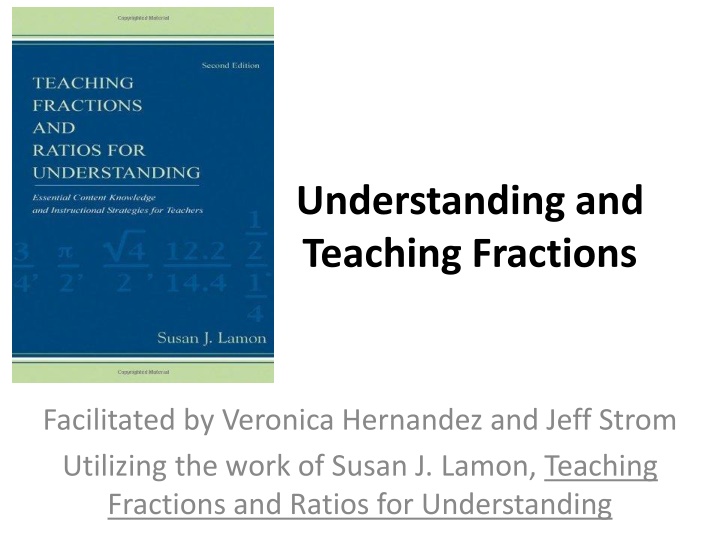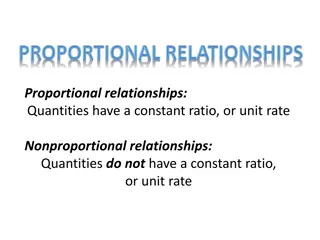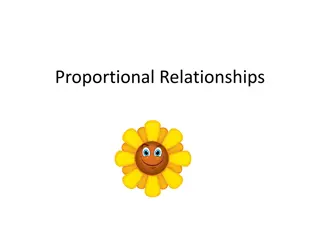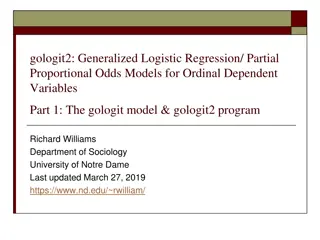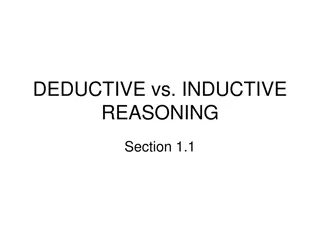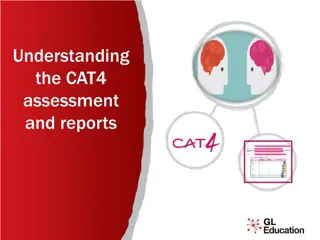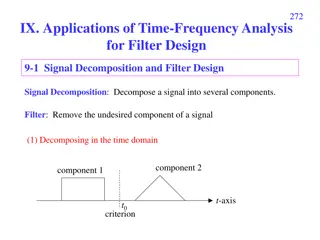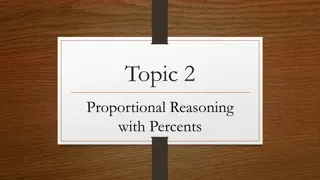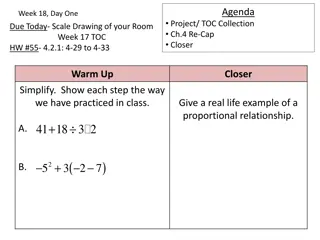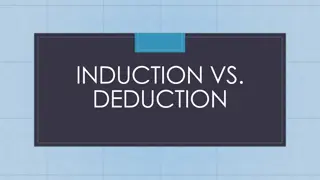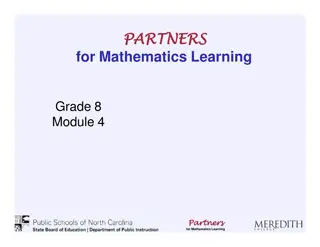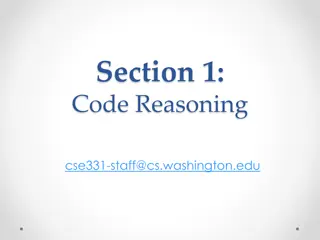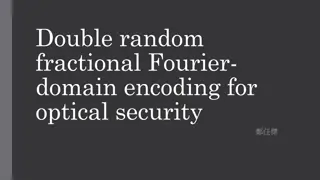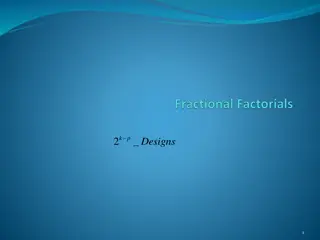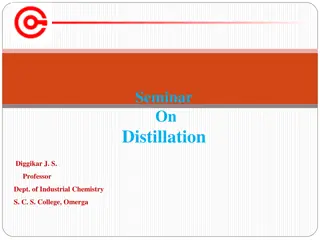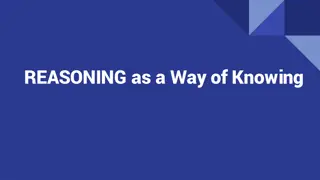Mastering Fractional and Proportional Reasoning Workshop
Dive into the world of fractions and proportions in this workshop facilitated by Veronica Hernandez and Jeff Strom, based on the work of Susan J. Lamon. Explore critical components like units, equivalence, comparison techniques, and fraction sense, without relying on traditional rules. Embrace reasoning over mechanized procedures to unleash powerful ways of thinking. Challenge yourself to solve tasks without proportions, emphasizing mental processes and conscious analysis. Discover the intricacies of proportional reasoning and the active role of instruction in its development.
Download Presentation

Please find below an Image/Link to download the presentation.
The content on the website is provided AS IS for your information and personal use only. It may not be sold, licensed, or shared on other websites without obtaining consent from the author.If you encounter any issues during the download, it is possible that the publisher has removed the file from their server.
You are allowed to download the files provided on this website for personal or commercial use, subject to the condition that they are used lawfully. All files are the property of their respective owners.
The content on the website is provided AS IS for your information and personal use only. It may not be sold, licensed, or shared on other websites without obtaining consent from the author.
E N D
Presentation Transcript
Understanding and Teaching Fractions Facilitated by Veronica Hernandez and Jeff Strom Utilizing the work of Susan J. Lamon, Teaching Fractions and Ratios for Understanding
Pre-Workshop Discussion Tree house Task How did you solve it without using proportions? What is you justification.
Fractions Key question: If we were to take away all of the rules for fraction operations, what would we teach? You would have to teach reasoning. You may find it difficult to abandon fraction rules and procedures, but forcing yourself to work without them will unleash powerful ways of thinking.
Beyond Mechanization We typically do not associate reasoning with rule-driven or mechanized procedures, but rather, with mental, free-flowing processes that require conscious analysis of the relationships among quantities. Read and discuss the 5 problems on page 5 What are you noticing? 5
Goals Gain understanding of the 7 Critical Components of Powerful Fractional and Proportional Reasoning. Develop the ideas of units, equivalence, techniques for comparison, fraction sense, a comfort and flexibility in fraction thinking. Identify the 5 rational number interpretations and ways they might be learned during instruction student approaches Interpretations are tightly intertwined
Investigation Solve mentally without proportional procedures. Page 11 (1-10) Think about each task and explain the solution without using rules and symbols. 11
Investigation 2 People and Nuts How is the task different from the tasks on page 11? What is the unit of the solution? Why is this so special? 8
Lamons Statements For too long, proportional reasoning has been an umbrella term, a catch-all phrase that refers to a certain facility with rational number concepts and contexts. Yet, the fact that most adults do not reason proportionally-estimate exceeds 90% presents compelling evidence that this reasoning process entails more than developmental processes and that instruction must play an active role in its emergence.
Lamons Statements Many people who have not developed their proportional reasoning ability have been able to compensate by using rules in algebra, geometry, and trigonometry courses, but, in the end, the rules are a poor substitute for understanding. They are unprepared for real applications in statistics, biology, geography, or physics. Purposes of this session, fractions will be used with proportional reasoning and will refer to the ability to scale up and down in appropriate situations and to supply justifications for assertions made about relationships in situations involving simple direct proportions and inverse proportions. Understanding and reasoning with simple direct and inverse proportions is an appropriate goal for students because these simple proportions are so intimately tied to rational number understanding and operations.
Critical Components of Powerful Reasoning Part- Whole Measure Operator Ratios Quotient
I. Sharing and Comparing 1. Mathematics Activity a) #2 pg94 b) #5 pg 96 2. Reading pages 88-94 3. Reflection page 98 (1-2) 4. Classrooms Implications pages 98 94 96
Big Idea Fair Share starts early in grade 2 Fair Share and Partitioning are the roots of understanding equivalence When Partitioning: Unit must be divided equally If the unit consists of more than one item, the items must be the same size Equal mean equal in amount, but shares do not have the same number of pieces Equal shares do not have to have the same shape Students can choose the shape to use when solving tasks
II. Measurement 1. Mathematics activity: OJ task p 43 2. Read Some principles of measurement Pg 41-42 (stop at measuring more abstract ) 3. Activity Pg 46 problem 10, 13 4. Reflection pg48 5. In the Classroom pg 48
Big Ideas: Measurement Measurement ideas develop and deepen over time. Therefore, we should continue to focus on measurement even while we proceed with fraction instruction. Partitioning units Precision and density Compensatory Principle- the smaller the unit the more you need to measure and the larger the unit the less you need to measure Approximation Principle- One can always measure with more precision. Recursive Partitioning Principle- No gaps or overlapping units. Breaking units into subunits. Rather than treating measuring and measurement as a specific unit of study, opportunities should be seized whenever possible during instruction to make measurement issues more explicit.
III. Relative and Absolute Thinking Mathematical Investigation Trees page 29 Read: Two Perspectives of Change page 30 Snakes Task Relative Thinking and Understanding Fractions and Encouraging Multiplicative Thinking pages 32-34 Reflection page 38 (1-3)
Big Ideas: Multiplicative Thinking and Preserving Ratios The process of addition is associated with situations that entail adding, joining, subtracting, separating, and removing actions with which children are familiar because of their experiences with counting and whole number operations. The process of multiplication is associated with situations that involve such processes as shrinking, enlarging, scaling, duplicating exponentiating, and fair sharing. Students will find that additive transformations do not work. However, this takes time and experience, and it does not happen until the student can detect certain quantities named intensive quantities. Intensive quantities are ratios that are formed by comparing two other quantities and they are not always explicit in the wording of a problem. Like the people and nuts task on pg 8. What/where does the pounds per person come from?
IV. Quantities and Covariation Which quantities are changing? a balloon is floating into the sky? Children sharing candy Read: pages 55- middle of 58 stop at In addition to pictures C-Rods Activity page 60 #3, #7, #9 Reflection page 63 In the Classroom: page 63
Big Ideas: Quantities and Covariation Children have a great deal of experience and intuitive knowledge. Whenever possible, it is best to build upon that knowledge. It is not the case that students cannot reason about quantities and change; it is simply that no one has asked them to think about these things before. This is the study of relationships among quantities Invariance: The whole remains, whatever may be the arrangement of its parts, the change in its form, or its displacement in space or time.
Reflection Exit ticket
Day 2 Welcome Back! Conga Line: What are some thoughts about yesterday s work that are circling in your mind?
Reasoning Up and Down What fraction is represented? Which answer is correct? 5, 2 , 5/3 or 3/5, 1 Reading pg. 65, first paragraph pg 67, pg 68-70
Reasoning Up and Down Mathematics Activity Pg 71 pattern block Reflection page 75 #1, #3 Inside the Classrooms page 76
Big Ideas: Reasoning Up and Down Unit matters. It answers how much Other names The whole The unit whole The unit will always be given or enough info to find it will be given Students need to experience various wholes (not just pizza) unit progression pg 68-69 Reasoning about the unit is what task solving is all about.
Unitizing Mathematics Activity A case of coke pg 82 Read: page 78,paragraphs, 82-83 ( up to Sam example) Activities: #4, #6 Reflection page 87 #1 and #3 In the Classrooms
Big Idea: Unitizing Unitizing refers to the process of constructing chunks It subjective process: experience and variable in application Unitizing is a natural process Flexibility is important: Depending on the context, chunking one way may be more advantages than another chunking
Critical Components of Powerful Reasoning Part- Whole Measure Operator Ratios Quotient
11 4 ? What is the answer? 2 2 3 4 2.75 3 11 11 11 1 4 4 or 4
5 Interpretations of Rational Numbers Part-Whole Comparisons With Unitizing Quotients Operators Measures Ratios Part- Whole Measure Operator Ratios Quotient 226
Critical Components of Powerful Reasoning Part- Whole Measure Operator Ratios Quotient
Changing Instruction Read bottom page 9 top of 10 Discuss in table groups
How Will You Change The Teaching? 3 Ways 1. The Bits and Pieces Approach a) As you read the chapters, you probably came across some activities or some ideas that you liked and with which you felt comfortable. Incorporate these into your current fraction instruction. b) Assign problems from this book to your students for homework. Ask them to discuss the problems at home with parents or older brothers and sisters. Spend some time each week discussing them. c) Begin every class by doing an activity from one of the central structures. Rotate through each of the shaded nodes of the diagram, and put a problem on the overhead so that students do it immediately as they come into the classroom. Before proceeding with the day s lesson, take a few minutes to discuss it.
How Will You Change The Teaching? 3 Ways 2. Slow and Steady Change Choose one or two of the nodes each year and make it your project to make material from those nodes an integral part of your fraction instruction. 232
How Will You Change The Teaching? 3 Ways 3. School Commitment a) The easiest change to make is to teach part whole with unitizing. It is not too radically different from current part whole instruction and it is not a difficult change to make. The following year, work in material from the other nodes of the diagram. b) Begin fraction instruction with one of the other rational number interpretations: quotient, operator, measure, or ratio, and simultaneously enhance instruction with material from the central structures.
Reflections Thank you! You are appreciated! Evaluations www.thetrc.org/pdsurvey Click & Learn via email
